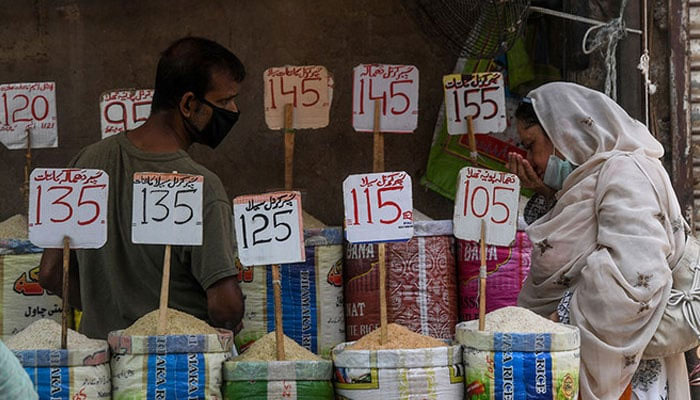Weekly inflation falls 1.29pc for fourth straight week
ISLAMABAD: Weekly inflation rate, as measured by the Sensitive Price Index (SPI), fell for the fourth consecutive week, declining by 1.39 percent in the week ending May 9, the Pakistan Bureau of Statistics (PBS) said on Friday.
The SPI, which measures the prices of 51 essential items, recorded a year-on-year increase of 22.3 percent, the lowest reading since June 2, 2022.Furthermore, the week-on-week decline of 1.39 percent represents the highest weekly decrease since the week ending October 19, 2023, when it dropped 1.7 percent compared to the preceding week.
During the past two years, the highest weekly year-on-year reading was recorded at 48.35 percent in the week ending on May 4, 2023.Given the significant decline in SPI over recent weeks, analysts anticipate a substantial drop in the monthly headline inflation measured by the Consumer Price Index (CPI).
In April 2024, the CPI also fell for the fourth straight month to 17.3 percent year-on-year, down from March's reading of 20.68 percent. Economic experts now expect that the month of May 2024’s CPI might fall below 15 percent.
They also expect that the SBP’s benchmark policy rate may come down to 15 percent next year, from the existing record high of 22 percent. Notably, the central bank raised the policy rate to 22 percent in June 2023 and has kept it unchanged for the last seven meetings of its Monetary Policy Committee (MPC) meetings. The latest one met on April 29, 2024.
Notably, after 37 months of continuous negative real interest rates, it has turned positive since March 2024. In April, it remained positive at 4.7 percent, and in May it could go further green with inflation drop.
The weekly percentage change by income groups showed that SPI decreased across all quantiles ranging -0.99 percent and -1.53 percent.The lowest income group experienced a weekly fall of 0.99 percent, while the highest income group experienced a fall of 1.53 percent.
On a yearly basis, SPI increased across all quantiles ranging between 15.95 percent and 25.88 percent. Yearly SPI for the lowest income Group increased by 15.95 percent while the highest income group recorded an increase of 19.99 percent.
According to the SPI bulletin, of 51 items the price indicator is tracking, 12 items prices increased, 13 decreased, and the other 26 prices were unchanged over the previous week. Notable reductions were observed in the prices of onions which dropped by 19.2 percent to Rs127/kg, chicken (live) by 18.8 percent to Rs341/kg, wheat flour by four percent to Rs1,980/20kg bag, LPG by 3.67 percent to Rs2,992/11.67kgcylinder, bananas by 2.32 percent to Rs146/dozen and garlic by 1.4 percent to Rs599/kg over the prices of previous week.
Likewise, basmati rice (broken) prices were reduced by 0.75 percent, mustard oil & sugar by 0.48 percent each, and firewood became cheaper by 0.23 percent.Whereas, some items experienced price hikes, with tomatoes up by 19.24 percent to Rs86/kg, eggs (farm) by 4.7 percent to Rs258/dozen, and potatoes costlier by 4.4 percent to Rs88/kg against the prices of the previous week.
Similarly, some items were costlier by less than a percent including gram pulse, cooking oil, beef, vegetable ghee, and fresh milk.The PBS further reported that for the lowest income group earning less than Rs17,732 per month, there was a weekly decrease of 0.99 percent, while the highest income group earning over Rs44,175 per month saw a fall of 1.53 percent. Yearly, the SPI for the lowest income group increased by 15.95 percent, while the highest income group recorded a rise of 19.99 percent. Notably, the median quintile (Rs22,889 to Rs29,517) saw a weekly decline of 1.35 percent while an increase of 25.88 percent over the same week of the previous year.
On a year-on-year basis, gas prices hiked by 570 percent for the lowest consumer slab, followed by a 119 percent spike in onion prices. Similarly, tomato prices increased by 101 percent, and garlic and chili powder by 72 percent each. Powder salt was expensive by 33 percent, energy-saving bulbs and shirting by 30 percent each. Likewise, gents' sandals were costlier by 25 percent and mash pulse and beef by 23 percent each. The tea prepared was 20 percent more expensive than the previous year.
Conversely, on year-on-year, bananas were cheaper by 39 percent, wheat flour by 28 percent, cooking oil 5 Litre by 20 percent, vegetable ghee by 17 percent, mustard oil by 13 percent, LPG 10.5 percent, eggs 7.9 percent and diesel by 2 percent.
-
 Zoe Saldana Overtakes Scarlett Johansson To Become Highest Grossing Actor Of All Time
Zoe Saldana Overtakes Scarlett Johansson To Become Highest Grossing Actor Of All Time -
 Former Congressional Employee Sold Stolen Government Phones For $150k
Former Congressional Employee Sold Stolen Government Phones For $150k -
 Joe Keery Credits Friends For Rare Experience
Joe Keery Credits Friends For Rare Experience -
 Jackson White Teases Darker Turn For Stephen In 'Tell Me Lies' Season 3
Jackson White Teases Darker Turn For Stephen In 'Tell Me Lies' Season 3 -
 Chris Hemsworth Leans On Matt Damon Amid His Shaky Marriage To Elsa Pataky?
Chris Hemsworth Leans On Matt Damon Amid His Shaky Marriage To Elsa Pataky? -
 Friends Of Prince William 'aghast' As King Charles Offers Olive Branch To Harry, Meghan Markle
Friends Of Prince William 'aghast' As King Charles Offers Olive Branch To Harry, Meghan Markle -
 What Cancer Does Colleen Hoover Have?
What Cancer Does Colleen Hoover Have? -
 Zayn Malik Drops Special Surprise For Fans On His 33rd Birthday
Zayn Malik Drops Special Surprise For Fans On His 33rd Birthday -
 Nicola Peltz Sends Harsh Message To Beckhams With Brooklyn Comments
Nicola Peltz Sends Harsh Message To Beckhams With Brooklyn Comments -
 Apple Martin 'lashes' Out At Mom Gwyneth Paltrow For Pushing Her 'too Hard'
Apple Martin 'lashes' Out At Mom Gwyneth Paltrow For Pushing Her 'too Hard' -
 Meghan Markle Going To 'humiliate' Prince Harry With UK Trip
Meghan Markle Going To 'humiliate' Prince Harry With UK Trip -
 Pastor Jailed After Secretly Filming Woman In Store
Pastor Jailed After Secretly Filming Woman In Store -
 Julio Iglesias Faces Serious Abuse Accusation
Julio Iglesias Faces Serious Abuse Accusation -
 Buckingham Palace’s ‘liability’ Prince Harry Comes Under Fire: ‘Can Really Harm King Charles’
Buckingham Palace’s ‘liability’ Prince Harry Comes Under Fire: ‘Can Really Harm King Charles’ -
 Emily Bader Reveals Inspiration Behind Choosing Latest Project
Emily Bader Reveals Inspiration Behind Choosing Latest Project -
 Anthropic Rolls Out Claude Cowork For Non-coders
Anthropic Rolls Out Claude Cowork For Non-coders




